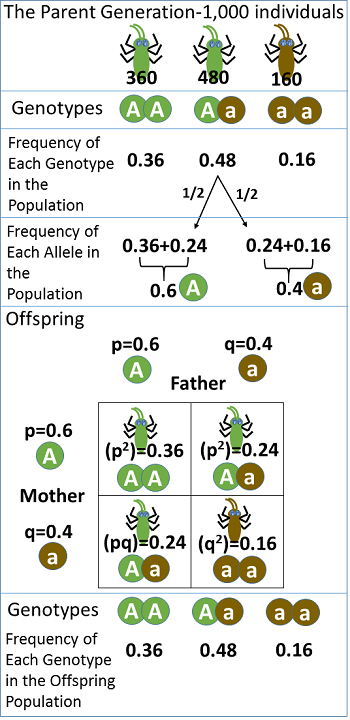Revisiting the Hardy-Weinberg Equilibrium
The Hardy-Weinberg principle posits that if a population is not affected by mutation, selection, migration, or genetic drift, and if random mating occurs, the frequencies of alleles and genotypes will remain in equilibrium across generations. In this idealized state, the frequencies of alleles ‘A’ (dominant) and ‘a’ (recessive) are represented by ‘p’ and ‘q’, respectively. The principle provides a mathematical formula to predict genotype frequencies:
p2 + 2pq + q2 = 1
where:
- p² represents the proportion of individuals with the homozygous dominant genotype (AA),
- 2pq represents the proportion of individuals with the heterozygous genotype (Aa),
- q² represents the proportion of individuals with the homozygous recessive genotype (aa).
This model assumes that the sum of all allele frequencies equals 1 (i.e., p+q=1).

In molecular ecology and evolutionary biology, the Hardy-Weinberg principle provides a theoretical baseline against which real-world genetic data can be compared. By analyzing deviations from equilibrium, researchers can infer the presence of evolutionary forces or population-level changes:
- Natural Selection: If certain genotypes are found at higher or lower frequencies than expected, this can indicate that natural selection is favoring or disfavoring specific alleles. For instance, in a changing environment, certain traits may confer a selective advantage, leading to changes in allele frequencies.
- Genetic Drift: Small, isolated populations are particularly prone to random fluctuations in allele frequencies, known as genetic drift. Comparing genetic data to the Hardy-Weinberg equilibrium helps identify the impact of drift, which can lead to reduced genetic diversity or fixation of alleles.
- Gene Flow: Migration between populations can introduce new alleles and homogenize genetic differences. Significant deviations from expected allele frequencies can reveal historical or ongoing migration events that impact local genetic structure.
- Non-Random Mating: Mate choice preferences, inbreeding, or assortative mating can alter genotype frequencies, often increasing the proportion of homozygous individuals. These patterns can be detected through a Hardy-Weinberg Equilibrium analysis.
- Mutation: Although mutations are relatively rare, they provide the raw genetic material for evolution. If new mutations confer an adaptive advantage, they may increase in frequency over time, creating a noticeable deviation from Hardy-Weinberg expectations.
- Population Bottlenecks and Founder Effects: Events like population bottlenecks or founder effects can drastically alter genetic variation. Comparing the genetic composition of populations before and after such events reveals the long-term impacts on allele frequencies.
Media Attributions
- Hartsock_Hardy_Weinberg_Example © Angela Hartsock is licensed under a CC0 (Creative Commons Zero) license

